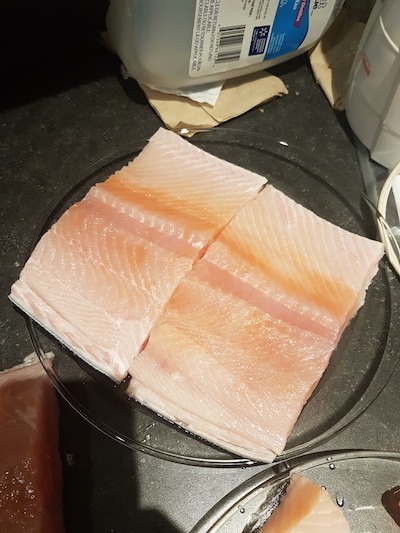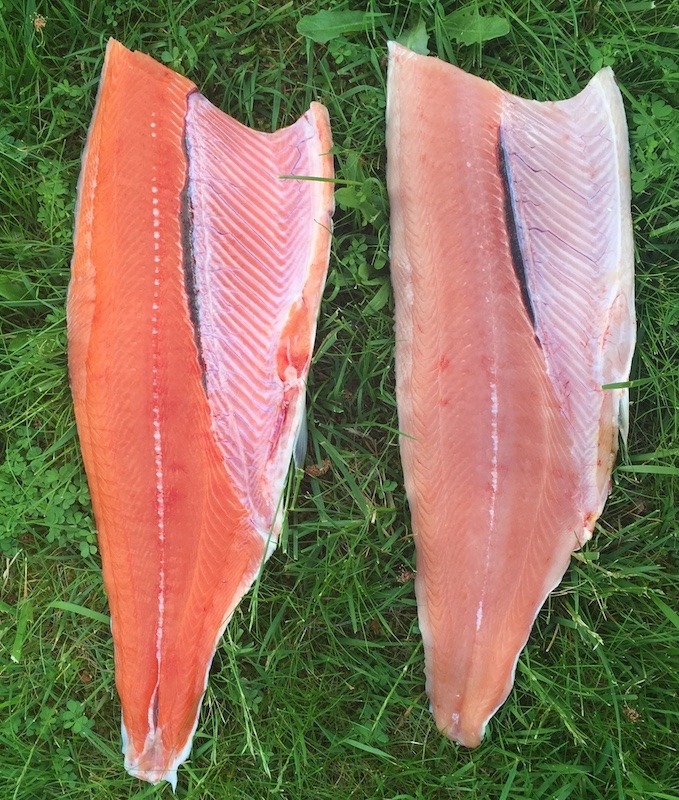Red and white are the national colours of Canada—white to symbolize the snow of winter, and red to symbolize our bank balances after we have to re-power the boat. At least I’m pretty sure about that.
However, from April to June the colours red and white take on another meaning. One topic rages beyond all others at fish cleaning stations across Eastern Vancouver Island: the qualities of white springs compared to that of standard red springs (Chinook), and, of course, why they are white in the first place.
White springs are so called because they have pale coloured flesh, ranging from almost translucent white to pale pink, and even marbled pink and white (known as calico salmon in some areas).
One cannot identify a white from the outside. However, if you look at the gills, you should be able to see a noticeable paleness.

White springs can be found in various river systems from Alaska to the Fraser River. Commonly 5% to 30% of any particular run of Chinook will be whites. In some smaller rivers, this can range up to 100% of the run. Fishermen have always called these fish Columbians, as they were thought to be from the Columbia River system. However, recent DNA analysis (done with samples collected by volunteer sport fishers from Nanaimo) have found that they are in fact mostly from the Fraser River system, specifically the Harrison and Stave.
What is White Salmon?
So, why are they white? Over the years I’ve heard many theories as to why some salmon have white flesh instead of red. Traditionally, many fishermen thought that the colour of a salmon was due to its diet. Whites were thought to eat more herring, and reds more shrimp and krill. Another thought was that the whites are a subspecies of normal red Chinook. In fact, they are the same species of Chinook: Oncorhynchus tshawytscha. The reason for the colouration is due to the white salmon’s genetic inability to metabolize the naturally occurring pigment in some of its foods. These pigments are known as carotenoids, and they are found in krill, shrimp, crabs, and many other crustaceans. The salmon can metabolize the proteins from these creatures but not the pigment. This leads to pure white flesh. Some salmon have a limited ability to metabolize the pigments, and this leads to marbled flesh. Either way, both types are healthy and have similar amounts of Omega 3 fatty acids, lipids, and proteins. According to the research I could find, they are equally nutritious. Personally, I think the whites have more fat and flavor, so I question whether they are completely equal. Also, this higher fat content is possibly not just due to the colour of the meat. Fat content in salmon may be related to the particular run they belong to or how far up river they are genetically predisposed to travel. I’m just speculating, but I think that salmon with long migrations probably carry more fat reserves. There is certainly much we don’t know about all salmon, and white springs in particular.
Does White Salmon Meat Taste Good?
Historically, commercial fishermen in British Columbia received less money for white springs than reds. Therefore, the impression that they are inferior crept into many a sport fisher’s minds. I’ve often heard anglers at the gutting trough complaining that they caught a white spring. While they certainly don’t have the bright red of other salmon, I personally feel that what they might lose out in appearance, they more than make up for in flavour. They are much fattier, and therefore richer and moister than other salmon. They don’t dry out as easily when cooking, especially BBQing. Note that I use the term “fatty” or “high fat” as a compliment regarding salmon and most meats. It means meat with more flavor and moisture content.
What are Ivory Kings?
These days professional fish buyers and chefs have realized the benefits of white springs and actually pay more for them than for reds. Americans call them “Ivory Kings”, a name I quite like. They command top dollar in restaurants and in Seattle’s famous Pike Place Fish Market.
Here are a few tips about preparing them, tips that can actually be applied to most large salmon…
Tips For Preparing Salmon
First, they don’t last in the freezer as long as other salmon. This is due to their high fat content, which over time can take on a fairly strong flavor. However, as they are the first fish of the season, it is probably best to just eat them fresh. I generally try to use up most of my frozen salmon over the winter, so by April I’m always looking forward to my first meal of fresh white spring.
I find it is best to remove their belly strips (about two inches on either side of the center of the belly) prior to freezing. This is the fattiest part and is also my traditional after-fishing meal. I take the strips and maybe a steak or two and pan fry them in butter or olive oil on a medium heat, with dill, lemon juice, and sea salt added at the end. I typically serve this with new potatoes and steamed asparagus. I prefer simple fish recipes with fresh fish, but I will pull out the teriyaki sauce or curry powder late in the year for fish that has been frozen.
Whites also lend themselves to hot smoking, and white springs make for some of the best smoked salmon. The smoking process cooks out a lot of the fat but retains the buttery softness that characterizes white spring meat.
To target these tasty fish, you have to get out early in the spring. This is normally mid-April to the latter half of May. They are what I call traveling fish, as they are migrating towards their home rivers. Therefore, they typically stay out in the middle of Georgia Strait on the “Salmon Highway.” They are also normally quite deep—fishers have to troll at 150 to 200 feet down and farther off shore than they would be fishing in the summer. While it may be hard to find the fish when one is fishing way out in the Straits, once you locate them, they are aggressive feeders and easy to hook.
In closing, I suggest you annually celebrate our great nation’s birthday in July with a red and white meal, only freshly available on the West Coast. BBQ a nice piece of white spring and a nice piece of red spring, and have a taste test to see if your family prefers one over the other.
Never miss an issue of Island Fisherman Magazine, Subscribe today!







I was under the understanding feeding as to whites finish off on herring before they spawn and reds finish off on shrimp prawns for there red flesh they both take herring needlefish anchovies to fatten up before there Journey ends of life cycle.?
I live on the west coast of Vancouver Island we live by the Burman River that has a 100% white spring spawn no red
Right beside the Gold River which has a 100% red spring spawn no white
We smoke the whites due to their oily nature
They smoke beautiful